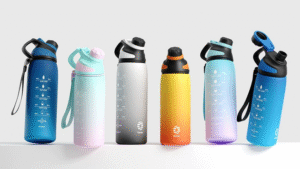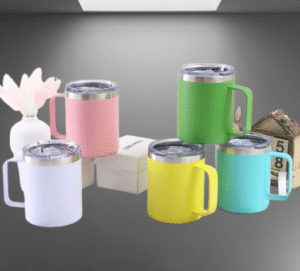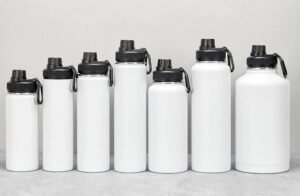You love the elegant look of clear glass mugs, but worry they might crack from the heat. This fear holds you back from offering this sophisticated option in your drinkware line.
Yes, glass mugs are excellent for coffee, especially those made from borosilicate glass. This type of glass is engineered to handle extreme temperature changes, making it perfectly safe for hot beverages while offering an exceptionally pure taste.
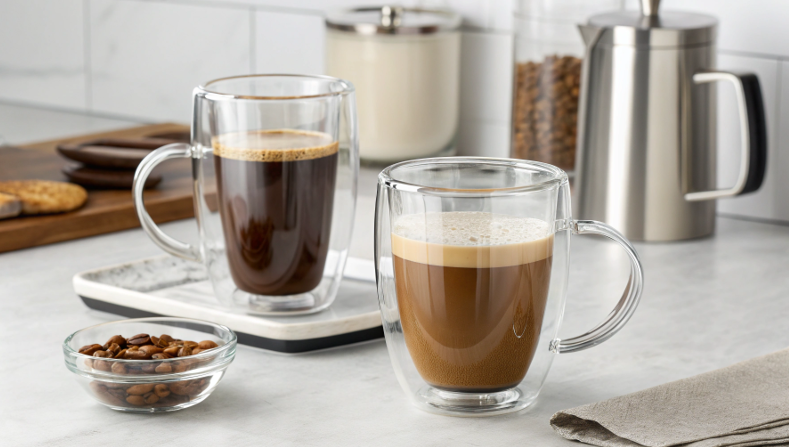
The first time a client asked me to source double-walled glass mugs, I knew they were tapping into something special. These mugs transform coffee into a visual experience. You can see the layers in a latte or the rich crema on an espresso. But the key, as I explained to them, is not just using any glass. It's about using the right kind. Choosing borosilicate glass is the crucial step that separates a beautiful, durable product from a potential customer complaint. For any product developer, understanding this distinction is fundamental.
What is the healthiest material for coffee mugs?
You want to assure your customers that your mugs are absolutely safe. But with so many conflicting claims about materials, it's hard to know which is truly the healthiest choice for daily use.
Glass is technically the healthiest material for coffee mugs because it's completely inert, meaning it won't leach anything into your drink or alter its flavor. However, high-quality, lead-free ceramic and 18/8 stainless steel are also exceptionally safe options.

When we talk about "healthy," we are really talking about being non-reactive. Coffee is acidic, so you want a material that won't interact with it. I always tell my partners to think about a chemistry lab. What is most of the equipment made of? Glass. There's a reason for that. It’s pure and stable. For drinkware, this same principle applies. Glass sets the gold standard for health and purity, ensuring the only thing your customer tastes is the coffee itself.
A Health-First Material Breakdown
For a product developer like Emily, choosing a material is a balance of features, but health is the one area with no room for compromise. Here's how the top materials stack up specifically for coffee.
- Glass: The Purest Choice
Borosilicate glass is non-porous and non-reactive. It contains no chemicals that can migrate into your drink, regardless of temperature or acidity. This guarantees the taste is exactly as the coffee brewer intended. It's the ultimate clean slate. - Ceramic: The Certified Safe Option
A high-quality ceramic mug with a modern, lead-free glaze is just as safe as glass. The glaze acts as a vitrified, non-porous barrier between the ceramic and the coffee. The key is certification. You must ensure your supplier provides documentation confirming it's lead-free and cadmium-free. - Stainless Steel: The Durable Guardian
Food-grade 18/8 stainless steel is another stable, non-leaching material. It doesn't react with coffee and is incredibly durable. While a very small percentage of people can detect a slight metallic taste, for most, it's a perfectly healthy and practical choice.
Is glass or ceramic better for coffee?
Choosing between glass and ceramic for your new coffee mug line is a difficult decision. Each material has dedicated fans, and picking the wrong one could mean failing to meet customer expectations.
Ceramic is better for retaining heat, keeping coffee warm for longer. Glass is better for taste purity and visual appeal, allowing you to see the coffee. The "better" choice depends entirely on what the user values most: warmth or sensory experience.
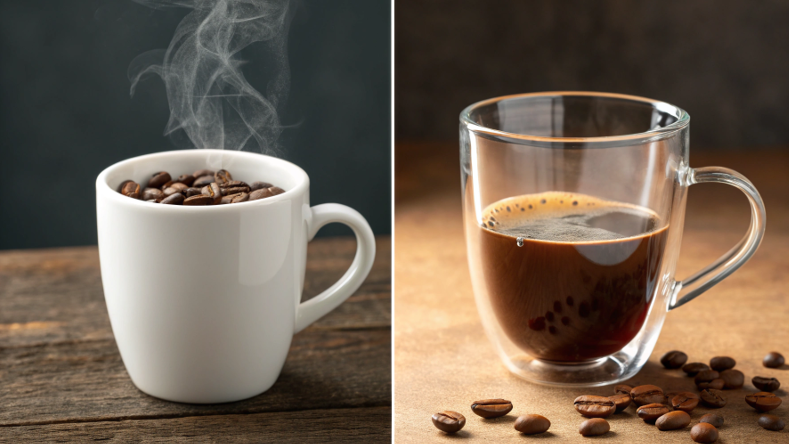
This is a classic debate, and I've seen brands succeed with both. The key is to know who you are selling to. Are you targeting the coffee connoisseur who wants to appreciate the color and crema of their single-origin espresso? Go with glass. Or are you targeting the person who wants a cozy, comforting mug that keeps their drink warm while they work? Ceramic is the answer. As a developer, you don't have to decide which is better overall, but which is better for the story your brand wants to tell.
A Head-to-Head Comparison for Coffee Drinkers
Let's break down the competition between these two materials across the factors that matter most for a coffee mug.
| Feature | Ceramic | Glass | Winner |
|---|---|---|---|
| Heat Retention | Excellent. Its thickness and porous nature trap heat effectively. | Fair. Loses heat faster than ceramic, unless it's a double-walled design. | Ceramic |
| Taste Purity | Very Good. High-quality inert glaze prevents flavor transfer. | Excellent. Completely non-reactive, offering the purest possible taste. | Glass |
| Aesthetics | Offers a traditional, cozy, and tactile feel. Endless color options. | Offers a modern, clean look. Allows you to see the coffee itself. | Tie (Depends on style) |
| Durability | Prone to chipping but generally quite sturdy. Resists scratches well. | Prone to shattering from drops, but borosilicate glass resists thermal shock. | Ceramic (for impacts) |
The verdict is clear: if the primary goal is keeping coffee hot, ceramic is superior. If the goal is appreciating the beverage with all your senses, glass has the edge.
Is it better to drink out of glass or ceramic?
You're trying to choose the ultimate material for your brand's drinkware. Glass and ceramic are top contenders, but you need to know which one provides the most superior overall drinking experience.
Neither material is universally "better"; the choice depends on the beverage and the occasion. Glass is often preferred for its purity with any drink, while ceramic is favored for the comforting, warm experience it provides for hot beverages.
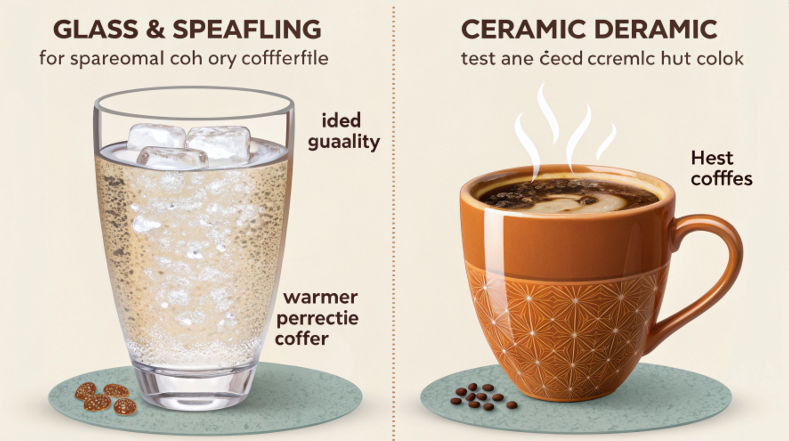
I always advise clients to think beyond a single use case. A person's favorite coffee mug might be ceramic, but they would probably never choose it for a glass of iced tea or a fancy cocktail. Glass offers a versatility that ceramic can't match. As a product developer, this insight is valuable. A line of glassware can serve many needs, from the morning water to the evening wine. A line of ceramic mugs, while excellent, is more specialized for the "hot and cozy" category.
Matching the Material to the Moment
The best user experience comes from using the right tool for the job. For drinkware, this means matching the material to the drink.
- For Hot Beverages (Coffee, Tea, Hot Chocolate):
Ceramic is often the emotional favorite here. Its substantial weight, smooth glaze, and superior heat retention create a feeling of comfort and ritual. It feels warm and protective in your hands. Single-walled glass can be hot to the touch, making ceramic a more practical choice unless you opt for a double-walled glass design. - For Cold Beverages (Water, Juice, Soda, Beer):
Glass is the undisputed winner for cold drinks. It doesn't sweat as much as single-walled ceramic might, and its clarity enhances the visual appeal of the drink—the bubbles in soda, the color of juice, the clarity of water. It feels clean and refreshing. - For Tasting & Analysis (Wine, Whiskey, Coffee Cupping):
Glass is the professional standard. Its absolute neutrality is essential when you need to analyze the aroma and flavor of a beverage without any interference from the vessel.
What is the healthiest cup to drink from?
Health-conscious consumers demand products that are verifiably safe. You need to confidently state which cup material is the healthiest to build brand trust and market your products with integrity.
The healthiest cup to drink from is glass, as it is the most inert and non-reactive material available. Close second choices are high-quality, certified lead-free ceramic and food-grade 18/8 stainless steel, which are also non-toxic.
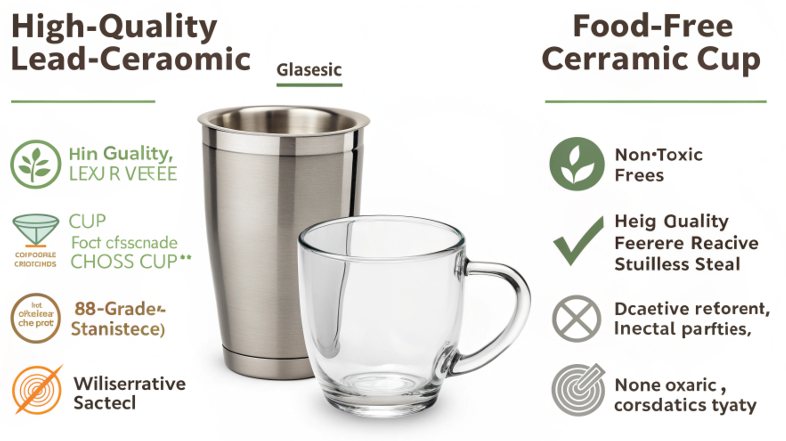
When a partner asks me this question, I always give them a tiered answer. While glass is the technical champion, it's not always the most practical. I reassure them that modern manufacturing and rigorous testing have made other materials just as safe from a chemical standpoint. The key isn't just picking the material; it's about validating its quality. A product developer's most important job is to demand proof—to get the safety certifications that turn a good material into a guaranteed safe product for their customers.
The Hierarchy of Healthy Materials
Think of material safety as a pyramid. At the very top is the one that is inherently safe, with others achieving the same level of safety through quality control and certification.
- Tier 1: Inherently Pure - Glass
Borosilicate glass sits at the top. It requires no additional layers or certifications to be safe from leaching. Its chemical stability is its core property. The only health risk it poses is a physical one if it breaks. - Tier 2: Certified Safe - Ceramic & Stainless Steel
These materials are elevated to the top tier of safety through proper manufacturing and verification.- Ceramic: Becomes ultra-safe when the manufacturer uses a lead-free, cadmium-free glaze and fires it at the correct temperature. You must get the lab reports to prove it.
- Stainless Steel: Is safe when it's the right grade (18/8 or 304). This ensures it has the right composition of chromium and nickel to be stable and resist corrosion from acidic drinks like coffee.
For a developer like Emily, this means the sourcing process is everything. You can confidently market a ceramic or steel mug as perfectly healthy, but only after you've done the due diligence to verify it meets global safety standards.
Conclusion
Glass mugs are an excellent choice for coffee, offering pure taste and a beautiful look. While ceramic holds heat better, certified borosilicate glass is a safe, stylish, and healthy option for any modern brand.

